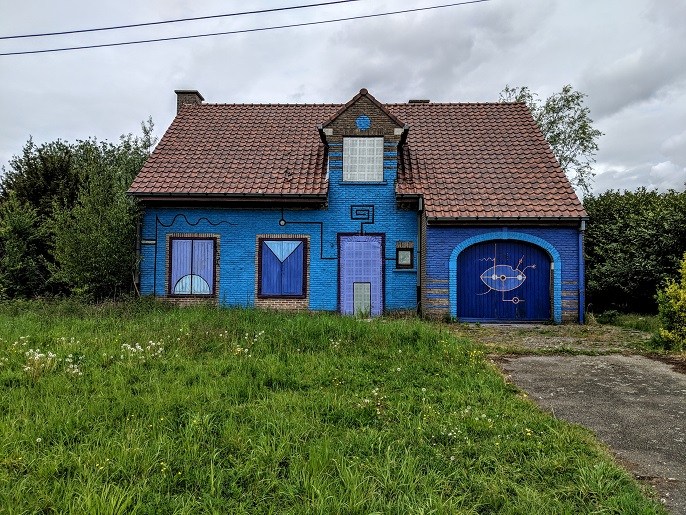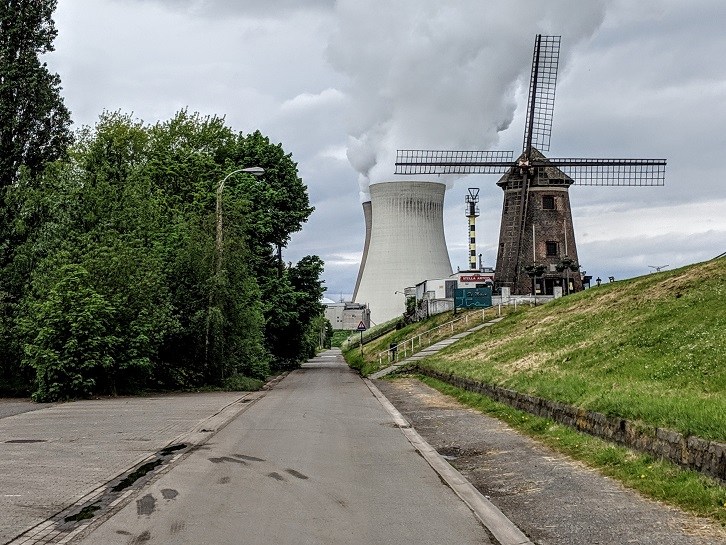The village of Doel ‒ situated on the Scheldt River in Flanders ‒ was meant to be destroyed in favour of progress. That didn't happen. Antwerp’s economic boom in the 20th century saw its port in need of expansion. Doel and its surrounding areas thus quickly became a target for demolition, a plan which was defeated through popular protests from the 1970s through the 1990s.
In 2019 ‒ years after the initial decision was put into place ‒ Doel still stands, albeit a shadow of its former self. A cycle trip from Antwerp to the village takes just over an hour and leads you past rows upon rows of shipping containers, operational buildings and logistic centres, which help make Antwerp the second largest port in Europe and the 17th largest in the world.
Once the industry and the ships are firmly behind you, a large graffiti message stating “Hier stopt de haven” (here the port ends) is the first obvious mark signalling your arrival in the area surrounding Doel.
A village in decline
The changes to Doel, which still had a population of 1,300 in the early 70s, are obvious from the first house.
Graffiti covers the majority of the village, a result of a mix of vandalism and intentional artwork to prevent the demolition of Doel. Everywhere you look, blocks of tourists explore the streets, crisscrossing the abandoned houses and stopping by the few hardy local establishments that serve food and drink.

© Jules Johnston The Brussels Times
For an apparently abandoned village, Doel certainly seems to have a life, and it’s not just tourists. Despite many inhabitants taking up offers of cash premiums and selling voluntarily around 2000, Doel still has residents who have endured, residents who are once again legally allowed to stay there.
“Court bailiffs appearing at doors used to be a fairly normal occurrence; and so was dealing with vandalism because the municipality wouldn’t provide the appropriate measures to help,” said Brian Waterschoot. Waterschoot is a member of Doel2020, a group responsible for promoting and representing the village through dialogue discussions about its future. “Looting, arson; these were all things that Doel regularly had to deal with, with little done to prevent them from happening,” he explained.
While there might not be many of them, the village’s few remaining inhabitants have a certain pride in their houses. As a result, there is a surreal contrast in the village between quaint homes and buildings left exposed to the elements and the whims of vandals.

© Jules Johnston The Brussels Times
"We settled with the authorities to stop further deterioration of buildings and vandalism by allowing people to live there. Metal plates have been installed to prevent access to abandoned houses, and a barrier that requires a Belgian ID card has been set up on the main road. People now feel a bit safer,” said Waterschoot. There are many buildings that could be habitable or that could be assigned a new function with a minimum of effort, he added.
"The current situation is that we’re just trying to live in relative peace. Everyone has different reasons for being in the area, but we all share a common concern," said Waterschoot. That concern is crystal-clear: What comes next?
The future of Doel
While it has existed in a state of administrative deadlock for years, progress is being made on the issue of Doel with a view towards the long term. After years of uncertainty, some things have changed for the better. One important reason for this is the “complex project”, which aims to create a framework to be implemented by 2030. This is the first opportunity we’ve had in years to sit together and discuss Doel, said Waterschoot.
In May 2019, the Flemish government announced that it had selected the so-called ninth alternative for the expansion of the port of Antwerp, which combines a limited new dock that connects to the existing Deurganck dock with new container capacity via a more compact building strategy.

© Jules Johnston The Brussels Times
In this scenario, Doel is safe, said Waterschoot. The future of Doel and the form the village can take are now the things that need to be researched carefully. Doel can never become the village it once was but the potential is enormous, explained Waterschoot. Its location close to the River Scheldt, the port, the history of the village and the historic buildings that are left are all important features which a future Doel could be proud of, he added.
One further plan for the future of Doel is a project being developed by the architects of the University of Leuven. The students have prepared detailed repair schedules for three valuable historic buildings in the derelict village. In this way, the students hope to warm the government and the people from the neighbourhood to the idea of the reconstruction of the village.
Another question that is yet to be answered is what would be done with the destroyed buildings. "In a way, it could make sense to keep some of these buildings in their current state, as they indeed show the impact of a government failing to act," said Waterschoot.
This decision may have given a reprieve to the people of Doel, but what happens next remains unknown. For now, the future of the village is similar to its past, uncertain, hopeful and well supported by a few loyal residents refusing to give it up.
By Jules Johnston

